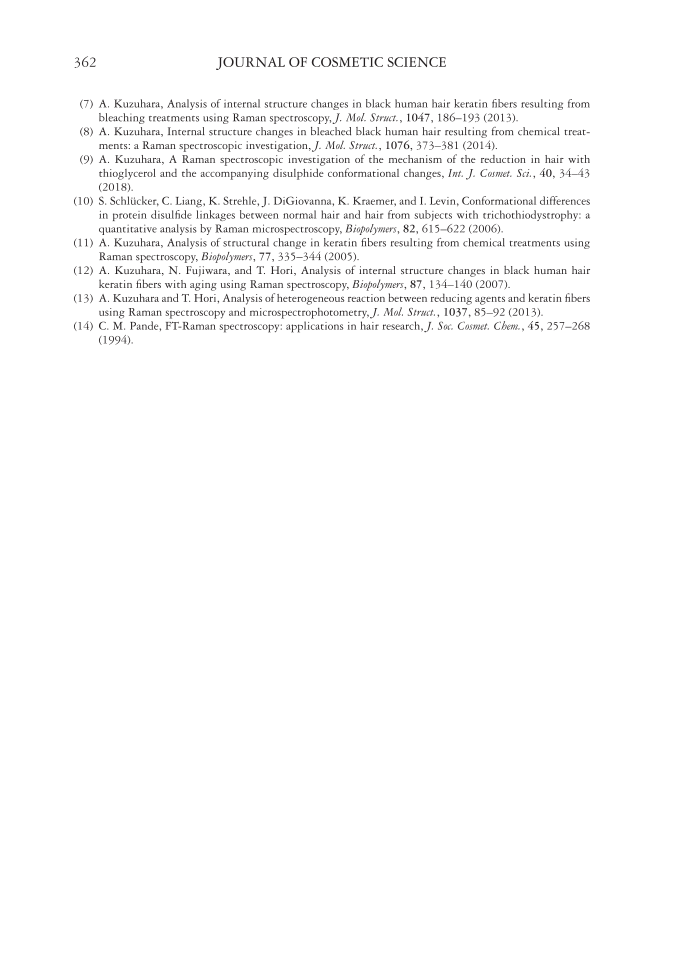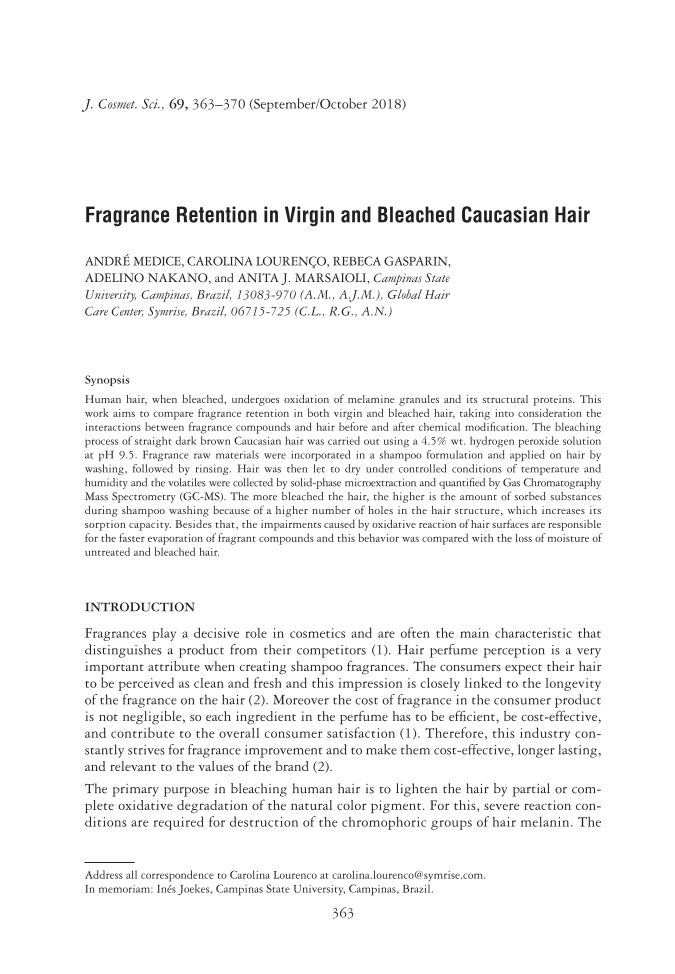JOURNAL OF COSMETIC SCIENCE 362 (7) A. Kuzuhara, Analysis of internal structure changes in black human hair keratin fi bers resulting from bleaching treatments using Raman spectroscopy, J. Mol. Struct., 1047, 186–193 (2013). (8) A. Kuzuhara, Internal structure changes in bleached black human hair resulting from chemical treat- ments: a Raman spectroscopic investigation, J. Mol. Struct., 1076, 373–381 (2014). (9) A. Kuzuhara, A Raman spectroscopic investigation of the mechanism of the reduction in hair with thioglycerol and the accompanying disulphide conformational changes, Int. J. Cosmet. Sci., 40, 34–43 (2018). (10) S. Schlücker, C. Liang, K. Strehle, J. DiGiovanna, K. Kraemer, and I. Levin, Conformational differences in protein disulfi de linkages between normal hair and hair from subjects with trichothiodystrophy: a quantitative analysis by Raman microspectroscopy, Biopolymers, 82, 615–622 (2006). (11) A. Kuzuhara, Analysis of structural change in keratin fi bers resulting from chemical treatments using Raman spectroscopy, Biopolymers, 77, 335–344 (2005). (12) A. Kuzuhara, N. Fujiwara, and T. Hori, Analysis of internal structure changes in black human hair keratin fi bers with aging using Raman spectroscopy, Biopolymers, 87, 134–140 (2007). (13) A. Kuzuhara and T. Hori, Analysis of heterogeneous reaction between reducing agents and keratin fi bers using Raman spectroscopy and microspectrophotometry, J. Mol. Struct., 1037, 85–92 (2013). (14) C. M. Pande, FT-Raman spectroscopy: applications in hair research, J. Soc. Cosmet. Chem., 45, 257–268 (1994).
J. Cosmet. Sci., 69, 363–370 (September/October 2018) 363 Fragrance Retention in Virgin and Bleached Caucasian Hair ANDRÉ MEDICE, CAROLINA LOURENÇO, REBECA GASPARIN, ADELINO NAKANO, and ANITA J. MARSAIOLI, Campinas State University, Campinas, Brazil, 13083-970 (A.M., A.J.M.), Global Hair Care Center, Symrise, Brazil, 06715-725 (C.L., R.G., A.N.) Synopsis Human hair, when bleached, undergoes oxidation of melamine granules and its structural proteins. This work aims to compare fragrance retention in both virgin and bleached hair, taking into consideration the interactions between fragrance compounds and hair before and after chemical modifi cation. The bleaching process of straight dark brown Caucasian hair was carried out using a 4.5% wt. hydrogen peroxide solution at pH 9.5. Fragrance raw materials were incorporated in a shampoo formulation and applied on hair by washing, followed by rinsing. Hair was then let to dry under controlled conditions of temperature and humidity and the volatiles were collected by solid-phase microextraction and quantifi ed by Gas Chromatography Mass Spectrometry (GC-MS). The more bleached the hair, the higher is the amount of sorbed substances during shampoo washing because of a higher number of holes in the hair structure, which increases its sorption capacity. Besides that, the impairments caused by oxidative reaction of hair surfaces are responsible for the faster evaporation of fragrant compounds and this behavior was compared with the loss of moisture of untreated and bleached hair. INTRODUCTION Fragrances play a decisive role in cosmetics and are often the main characteristic that distinguishes a product from their competitors (1). Hair perfume perception is a very important attribute when creating shampoo fragrances. The consumers expect their hair to be perceived as clean and fresh and this impression is closely linked to the longevity of the fragrance on the hair (2). Moreover the cost of fragrance in the consumer product is not negligible, so each ingredient in the perfume has to be effi cient, be cost-effective, and contribute to the overall consumer satisfaction (1). Therefore, this industry con- stantly strives for fragrance improvement and to make them cost-effective, longer lasting, and relevant to the values of the brand (2). The primary purpose in bleaching human hair is to lighten the hair by partial or com- plete oxidative degradation of the natural color pigment. For this, severe reaction con- ditions are required for destruction of the chromophoric groups of hair melanin. The Address all correspondence to Carolina Lourenco at carolina.lourenco@symrise.com. In memoriam: Inés Joekes, Campinas State University, Campinas, Brazil.
Purchased for the exclusive use of nofirst nolast (unknown) From: SCC Media Library & Resource Center (library.scconline.org)









































































































